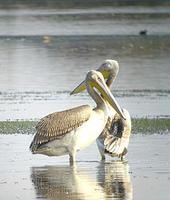Hula Valley Festival
White Pelican Pelecanus onocrotalus
History
Our knowledge of the area before the
mid-19th century is comparatively weak, but we do know that the Hula
Valley once contained one of the largest (5770 ha) and most diverse
wetlands in the Middle East. Tristram, writing in 1864, described it as
the most vast and impenetrable swamp he had visited. Until the late 1930s,
the human population, kept at a low level by persistent malaria, lived in
relative symbiosis with the Hula environment. In the 1830s the population
of the area largely consisted of Bedouin (the Ghawarna), Egyptian
soldiers, Mesopotamian Arabs and slaves, many of whom had been forced to
move to the area by Ibrahim Pasha, the Egyptian governor. These people
subsisted through keeping cattle, agriculture (corn, wheat and rice) and
principally by harvesting the paper reeds. One potential origin for the
name Hula is the talmudic word,
|

